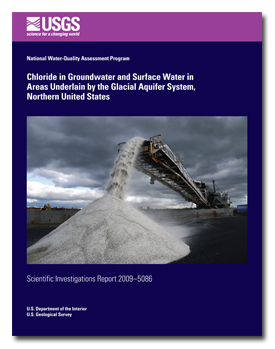Scientific Investigations Report 2009–5086

AbstractA study of chloride in groundwater and surface water was conducted for the glacial aquifer system of the northern United States in forested, agricultural, and urban areas by analyzing data collected for the National Water-Quality Assessment Program from 1991 to 2004. Groundwater-quality data from a sampling of 1,329 wells in 19 states were analyzed. Chloride concentrations were greater than the secondary maximum contaminant level established by the U.S. Environmental Protection Agency of 250 milligrams per liter in 2.5 percent of samples from 797 shallow monitoring wells and in 1.7 percent of samples from 532 drinking-water supply wells. Water samples from shallow monitoring wells in urban areas had the largest concentration of chloride, followed by water samples from agricultural and forested areas (medians of 46, 12, and 2.9 milligrams per liter, respectively). An analysis of chloride:bromide ratios, by mass, and chloride concentrations compared to binary mixing curves for dilute groundwater, halite, sewage and animal waste, potassium chloride fertilizer, basin brines, seawater, and landfill leachate in samples from monitoring wells indicated multiple sources of chloride in samples from wells in urban areas and agricultural areas. Water from shallow monitoring wells in urban areas had the largest chloride:bromide ratio, and samples with chloride:bromide ratios greater than 1,000 and chloride concentrations greater than 100 milligrams per liter were dominated by halite; however, the samples commonly contained mixtures that indicated input from sewage or animal waste. Chloride:bromide ratios were significantly larger in samples from public-supply drinking-water wells than from private drinking-water wells, and ratios were significantly larger in all drinking-water wells in eastern and central regions of the glacial aquifer system than in west-central and western regions of the glacial aquifer system. Surface-water-quality data collected regularly during varying time periods from 1991–2004 from 100 basins dominated by forested, agricultural, or urban land in 15 states were analyzed to determine maximum measured chloride concentrations. Samples from 15 sites in east, central, and west-central areas, collected primarily in winter, had chloride concentrations higher than the U.S. Environmental Protection Agency recommended chronic criterion concentration for aquatic life of 230 milligrams per liter. Concentrations of chloride in base-flow samples were predictive of maximum measured chloride concentrations, indicating that inputs of chloride from groundwater and (or) point-source wastewater discharges increase the likelihood of samples exceeding the recommended chronic aquatic criterion. Multiple linear regression analyses showed that the density of major roads, potential evapotranspiration, and the percentage of annual runoff from saturated overland flow were significant factors in describing the range of maximum measured chloride concentrations in the basins studied. Chloride loads and yields were determined at 95 surface-water-monitoring stations in basins dominated by forested, agricultural, or urban land. Annual chloride yield was largest in the urban basins (median of 88 tons per square mile) and smallest in the forested basins (median of 6.4 tons per square mile). The median chloride yield in the agricultural basins was 15.4 tons per square mile. Multiple linear regression analyses showed that the density of highways (roads in U.S. highway system), the number of major wastewater discharges in the basin, potential evapotranspiration, and urban minus agricultural land area were significant factors in describing the range of average annual chloride yields. Upward trends in chloride loads were apparent in several urban basins for which additional long-term data were available. Increases in chloride loads over time may be related to a variety of factors, including increases in road area and consequent deicing, increases in wastewater and septic-system discharges, recycling of chloride from drinking water, and leachate from landfills and salt storage areas. |
For additional information contact: Part or all of this report is presented in Portable Document Format (PDF); the latest version of Adobe Reader or similar software is required to view it. Download the latest version of Adobe Reader, free of charge. |
Mullaney, J.R., Lorenz, D.L., Arntson, A.D., 2009, Chloride in groundwater and surface water in areas underlain by the glacial aquifer system, northern United States: U.S. Geological Survey Scientific Investigations Report 2009–5086, 41 p.
Foreword
Abstract
Introduction
Purpose and Scope
Sources of Salts to Water Resources
Natural Sources
Atmospheric Deposition
Weathering of Common Rocks, Minerals, and Soils
Salt Deposits and Brines
Anthropogenic Sources
Application of Deicing Salts
Landfills
Wastewater and Water Treatment
Agriculture
Methods of Data Analysis
Compilation of Environmental Data
Multiple Comparison Testing
Multiple Linear Regression Modeling
Estimation of Chloride Loads
Chloride in Groundwater and Surface Water
Groundwater
Sources of Chloride in Groundwater
Surface Water
Relation of Maximum Chloride Concentration to Explanatory Variables
Loads and Yields of Chloride from Forested, Agricultural, and Urban Basins
Relation of Chloride Yield to Explanatory Variables
Trends in Loads at Selected Sites and Evaluation of Sources of Chloride
Summary and Conclusions
References Cited
Appendix 1 Surface-Water-Quality Monitoring Stations Used in Analyses for Chloride Concentration or Load Estimation (or Both)